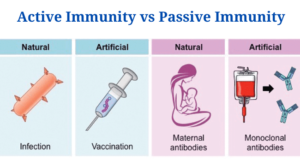What is Active Immunity ?
Active immunity is the straight response of the body towards pathogens. These pathogens are infectious microorganisms. They are also foreign substances that develop following an infection or vaccination.
What is Passive Immunity ?
Passive immunity is the transfer of active humoral immunity of ready-made antibodies. It is provided when someone is given an antibody to a disease rather than producing them through the immune system. Passive immunity occurs naturally. For instance, the fetus receives antibodies from the mother through the placenta.
Differences between Active Immunity and Passive Immunity
(Active Immunity vs Passive Immunity)
| Characteristics | Active Immunity | Passive Immunity |
| Definition | The process of stimulating the individual’s immune system to create antibodies and lymphocytes in order to provide protective immunity. | Immunity in which a person receives antibodies or lymphocytes produced by the immune system of another person. |
| Exposure to Antigen | Exposure to a pathogen or a pathogen’s antigen is required. | It is not essential to have come into contact with an infectious agent or its antigen. |
| Immune system involvement | The individual’s immune system is actively involved in the process. | The individual’s immune system is not actively involved, but rather passive. |
| Natural acquirement | When a person is exposed to an antigen or pathogen, they develop naturally (clinical infection). | When a foetus obtains antibodies from the mother through the placenta or when a breast-feeding child consumes antibodies in the mother’s milk, they develop spontaneously. |
| Artificial acquirement | Vaccines are used to confer it artificially. | Artificially conferred via the administration of premade antibodies. |
| Immunity type | Immunity that is both humoral and cell-mediated. | Only prepared antibodies can provide immunity. |
| Components | T cells, B cells, and antigen-presenting cells (cytotoxic T cells, helper T cells, memory T cells, and suppressor T cells) (B cells, dendritic cells, and macrophages). | Because the antibody is produced in advance, no immune cells are engaged. |
| Antibody production | Antibody generation is triggered by infection or an immunogen. | There is no antibody created, yet the information is conveyed directly. |
| Memory cell formation | Long-lasting memory cells are formed as a result of active immunity. | Immune memory cells are not produced. |
| Secondary response | The primary reaction is created after the initial exposure, and a much faster and stronger secondary response is established after a subsequent encounter to the same pathogen. | There isn’t a secondary answer. |
| Durability | The security provided is long-lasting. | The shield is merely temporary. |
| Response time | Because there is a lag period, the protective response takes time to develop. | There is no lag time, so the protection is immediate. |
| Reactivation | A return of illness or revaccination can reactivate the virus. | For renewed protection, frequent re-administration is required. |
| Booster effect | Antigen dosages given after that have a booster effect. | Due to immunological clearance, subsequent dosages are less effective. |
| Suitability | Active immunity is ineffective in protecting people who are immunocompromised or immunodeficient | In circumstances of immunocompromised, immunodeficient, or severe combination immunodeficiency, passive immunity is beneficial. |
| Use | Very effective for illness prevention. | As a post-exposure treatment, artificial passive immunity is effective. |
| Effectiveness of Protection | It offers effective defence. | The protection provided is ineffective and may not be comprehensive. |
| Adverse effect | It has been linked to autoimmune disorders and allergies, although it has no known negative effects. | Antisera exposure can cause a disease known as serum sickness. |
| Examples |
Natural — Antibodies are produced in reaction to a pathogenic illness, such as measles or the common cold. |
Natural – It is a natural process to receive antibodies from another creature (e.g. to the foetus through the colostrum or a newborn through breast milk). |
|
Artificial – Antibodies are produced artificially in response to a regulated exposure to a pathogen that has been weakened (i.e. vaccination). |
Artificial – Getting produced antibodies from a third party (e.g blood transfusions of monoclonal antibodies). |
Active Immunity vs Passive Immunity Citations
- https://www.thoughtco.com/active-immunity-and-passive-immunity-4134137
- The College of Physicians of Philadelphia (2018, January 10). Passive Immunization. Retrieved from https://www.historyofvaccines.org/content/articles/passive-immunization
- Encyclopaedia Britannica (2017, November 22). Immunization. Retrieved from https://www.britannica.com/science/immunization.
- Lydyard, P.M., Whelan,A.,& Fanger,M.W. (2005).Immunology (2 ed.).London: BIOS Scientific Publishers.
Related Posts
- Phylum Porifera: Classification, Characteristics, Examples
- Dissecting Microscope (Stereo Microscope) Definition, Principle, Uses, Parts
- Epithelial Tissue Vs Connective Tissue: Definition, 16+ Differences, Examples
- 29+ Differences Between Arteries and Veins
- 31+ Differences Between DNA and RNA (DNA vs RNA)
- Eukaryotic Cells: Definition, Parts, Structure, Examples
- Centrifugal Force: Definition, Principle, Formula, Examples
- Asexual Vs Sexual Reproduction: Overview, 18+ Differences, Examples
- Glandular Epithelium: Location, Structure, Functions, Examples
- 25+ Differences between Invertebrates and Vertebrates
- Lineweaver–Burk Plot
- Cilia and Flagella: Definition, Structure, Functions and Diagram
- P-value: Definition, Formula, Table and Calculation
- Nucleosome Model of Chromosome
- Northern Blot: Overview, Principle, Procedure and Results

















